Page 334 of 417
333 Practical hints
What to do if ...
Left display
Right display
Possible cause
Possible solution
H
Reactivate
tire press. monit.
�
A tire inflation pressure
warning message ap-
peared.
�
The tire inflation pressure in
one or more tires was in-
creased by over 0.3 bar.
�
Activate the tire inflation pressure monitor
(�page 266).
Tire pres.
monitor
currently
inactive
The tire inflation pressure mon-
itor is temporarily unable to
monitor the tire inflation pres-
sure due to:�
the presence of several
wheel sensors in the vehicle
�
excessive wheel sensor
temperatures
�
a nearby radio interference
source
�
unrecognized wheel sen-
sors mounted
�
Remove any additional wheel sensors from the vehicle,
e.g. when transporting a new set of tires.
As soon as the causes of the malfunction have been re-
moved, the tire inflation pressure monitor automatically be-
comes active again.
Page 336 of 417
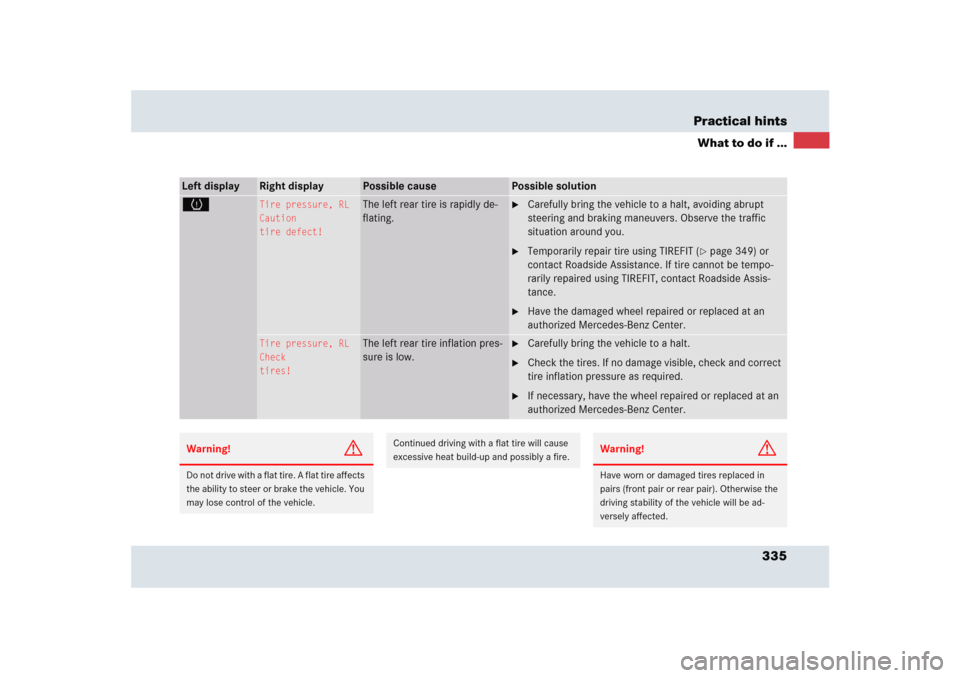
335 Practical hints
What to do if ...
Left display
Right display
Possible cause
Possible solution
H
Tire pressure, RL
Caution
tire defect!
The left rear tire is rapidly de-
flating.
�
Carefully bring the vehicle to a halt, avoiding abrupt
steering and braking maneuvers. Observe the traffic
situation around you.
�
Temporarily repair tire using TIREFIT (
�page 349) or
contact Roadside Assistance. If tire cannot be tempo-
rarily repaired using TIREFIT, contact Roadside Assis-
tance.
�
Have the damaged wheel repaired or replaced at an
authorized Mercedes-Benz Center.
Tire pressure, RL
Check
tires!
The left rear tire inflation pres-
sure is low.
�
Carefully bring the vehicle to a halt.
�
Check the tires. If no damage visible, check and correct
tire inflation pressure as required.
�
If necessary, have the wheel repaired or replaced at an
authorized Mercedes-Benz Center.
Warning!
G
Do not drive with a flat tire. A flat tire affects
the ability to steer or brake the vehicle. You
may lose control of the vehicle.
Continued driving with a flat tire will cause
excessive heat build-up and possibly a fire.
Warning!
G
Have worn or damaged tires replaced in
pairs (front pair or rear pair). Otherwise the
driving stability of the vehicle will be ad-
versely affected.
Page 337 of 417
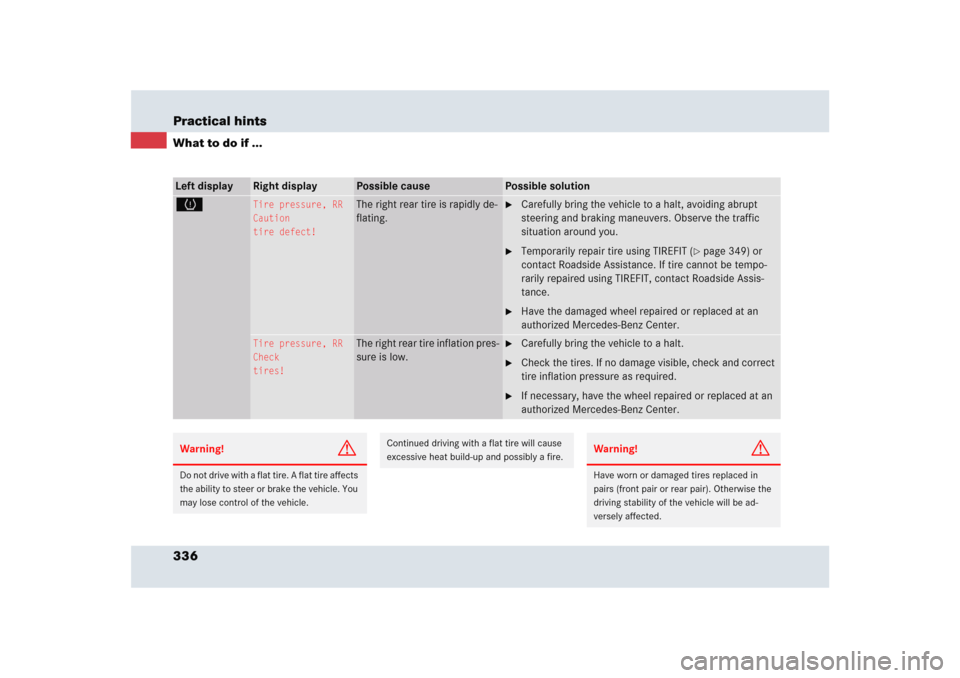
336 Practical hintsWhat to do if ...Left display
Right display
Possible cause
Possible solution
H
Tire pressure, RR
Caution
tire defect!
The right rear tire is rapidly de-
flating.
�
Carefully bring the vehicle to a halt, avoiding abrupt
steering and braking maneuvers. Observe the traffic
situation around you.
�
Temporarily repair tire using TIREFIT (
�page 349) or
contact Roadside Assistance. If tire cannot be tempo-
rarily repaired using TIREFIT, contact Roadside Assis-
tance.
�
Have the damaged wheel repaired or replaced at an
authorized Mercedes-Benz Center.
Tire pressure, RR
Check
tires!
The right rear tire inflation pres-
sure is low.
�
Carefully bring the vehicle to a halt.
�
Check the tires. If no damage visible, check and correct
tire inflation pressure as required.
�
If necessary, have the wheel repaired or replaced at an
authorized Mercedes-Benz Center.
Warning!
G
Do not drive with a flat tire. A flat tire affects
the ability to steer or brake the vehicle. You
may lose control of the vehicle.
Continued driving with a flat tire will cause
excessive heat build-up and possibly a fire.
Warning!
G
Have worn or damaged tires replaced in
pairs (front pair or rear pair). Otherwise the
driving stability of the vehicle will be ad-
versely affected.
Page 338 of 417
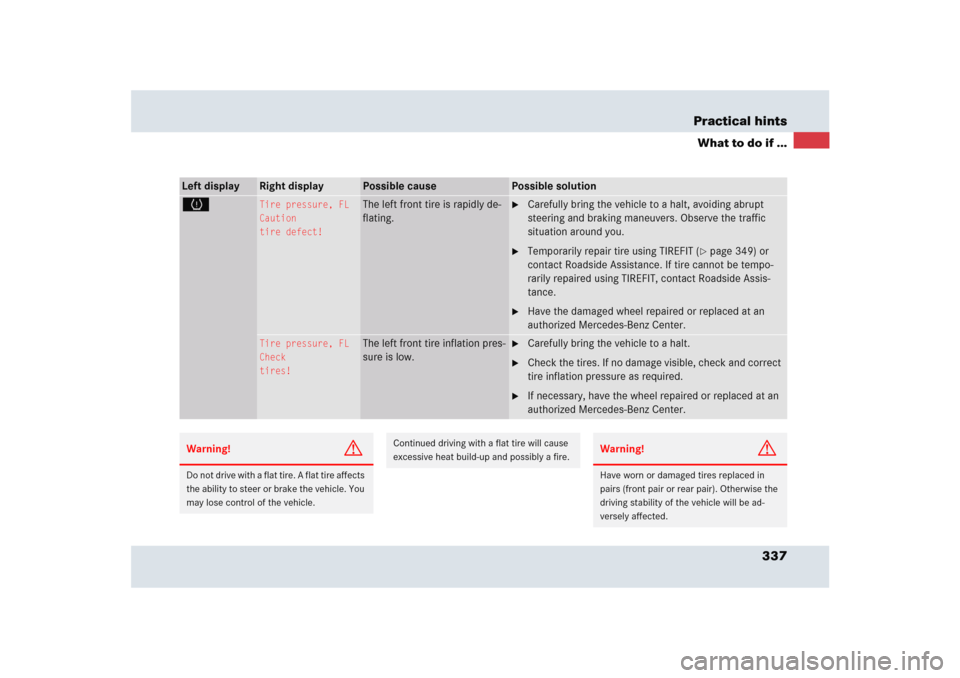
337 Practical hints
What to do if ...
Left display
Right display
Possible cause
Possible solution
H
Tire pressure, FL
Caution
tire defect!
The left front tire is rapidly de-
flating.
�
Carefully bring the vehicle to a halt, avoiding abrupt
steering and braking maneuvers. Observe the traffic
situation around you.
�
Temporarily repair tire using TIREFIT (
�page 349) or
contact Roadside Assistance. If tire cannot be tempo-
rarily repaired using TIREFIT, contact Roadside Assis-
tance.
�
Have the damaged wheel repaired or replaced at an
authorized Mercedes-Benz Center.
Tire pressure, FL
Check
tires!
The left front tire inflation pres-
sure is low.
�
Carefully bring the vehicle to a halt.
�
Check the tires. If no damage visible, check and correct
tire inflation pressure as required.
�
If necessary, have the wheel repaired or replaced at an
authorized Mercedes-Benz Center.
Warning!
G
Do not drive with a flat tire. A flat tire affects
the ability to steer or brake the vehicle. You
may lose control of the vehicle.
Continued driving with a flat tire will cause
excessive heat build-up and possibly a fire.
Warning!
G
Have worn or damaged tires replaced in
pairs (front pair or rear pair). Otherwise the
driving stability of the vehicle will be ad-
versely affected.
Page 339 of 417
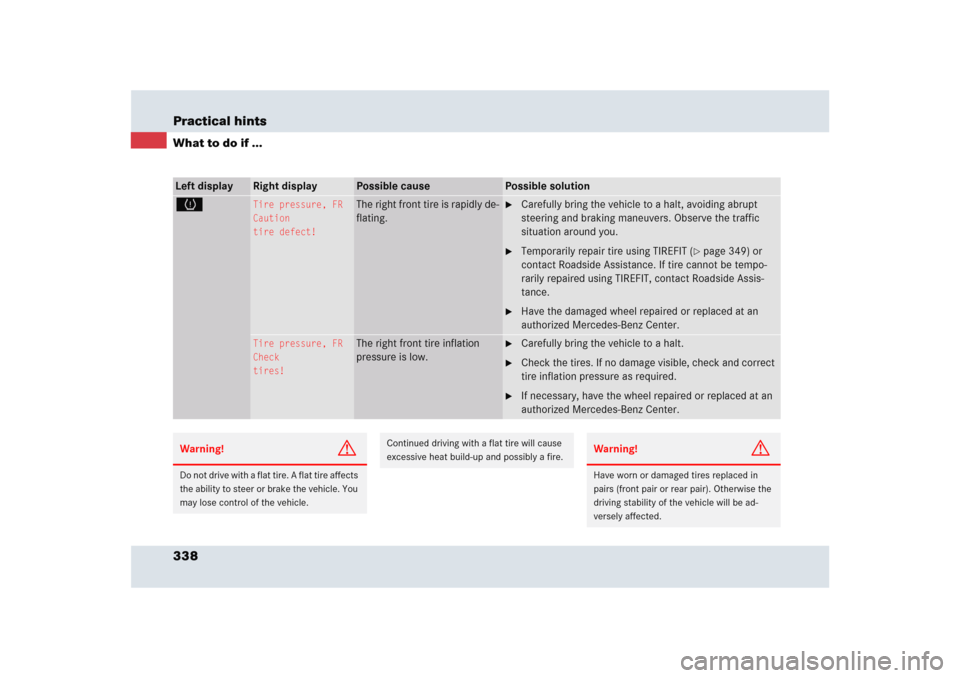
338 Practical hintsWhat to do if ...Left display
Right display
Possible cause
Possible solution
H
Tire pressure, FR
Caution
tire defect!
The right front tire is rapidly de-
flating.
�
Carefully bring the vehicle to a halt, avoiding abrupt
steering and braking maneuvers. Observe the traffic
situation around you.
�
Temporarily repair tire using TIREFIT (
�page 349) or
contact Roadside Assistance. If tire cannot be tempo-
rarily repaired using TIREFIT, contact Roadside Assis-
tance.
�
Have the damaged wheel repaired or replaced at an
authorized Mercedes-Benz Center.
Tire pressure, FR
Check
tires!
The right front tire inflation
pressure is low.
�
Carefully bring the vehicle to a halt.
�
Check the tires. If no damage visible, check and correct
tire inflation pressure as required.
�
If necessary, have the wheel repaired or replaced at an
authorized Mercedes-Benz Center.
Warning!
G
Do not drive with a flat tire. A flat tire affects
the ability to steer or brake the vehicle. You
may lose control of the vehicle.
Continued driving with a flat tire will cause
excessive heat build-up and possibly a fire.
Warning!
G
Have worn or damaged tires replaced in
pairs (front pair or rear pair). Otherwise the
driving stability of the vehicle will be ad-
versely affected.
Page 350 of 417

349 Practical hints
Flat tire
�Flat tire
The vehicle is equipped with the TIREFIT
kit.Preparing the vehicle�
Park the vehicle as far as possible from
moving traffic on a hard surface.
�
Turn on the hazard warning flashers.
�
Turn the steering wheel so that the
front wheels are in a straight ahead po-
sition.
�
Set the parking brake.
�
Move the gear selector lever to P.
�
Turn off the engine (
�page 58).
�
Remove the SmartKey from the starter
switch.
�
Open the driver’s door.
�
Have any passenger exit the vehicle at
a safe distance from the roadway.
Sealing tires with TIREFIT kit
Small tire punctures, particularly those in
the tread, can be sealed with TIREFIT.
TIREFIT can be used in ambient tempera-
tures down to -4°F (-20°C).
�
Foreign objects (e.g. screws or nails)
should not be removed from the tire.
�
Take TIREFIT, the sticker, and the elec-
tric air pump out of the trunk.
!A wheel change should only be carried
out at an authorized Mercedes-Benz
Center. Otherwise there is a danger of
damaging the vehicle by jacking it up
incorrectly.
iOpen door only when conditions are
safe to do so.Warning!
G
Keep TIREFIT away from sparks, open flame
or heat source.
Do not smoke.
Warning!
G
TIREFIT is a limited repair device. TIREFIT
cannot be used for cuts or punctures larger
than approximately 0.16 in (4 mm) and tire
damage caused by driving with extremely
low tire inflation pressure, or on a flat tire, or
a damaged wheel.
Do not drive the vehicle under such circum-
stances.
Contact your nearest Mercedes-Benz
Center for assistance or call Roadside
Assistance. !After using TIREFIT, the tire inflation
pressure sensor may have to be re-
placed.
��
Page 354 of 417
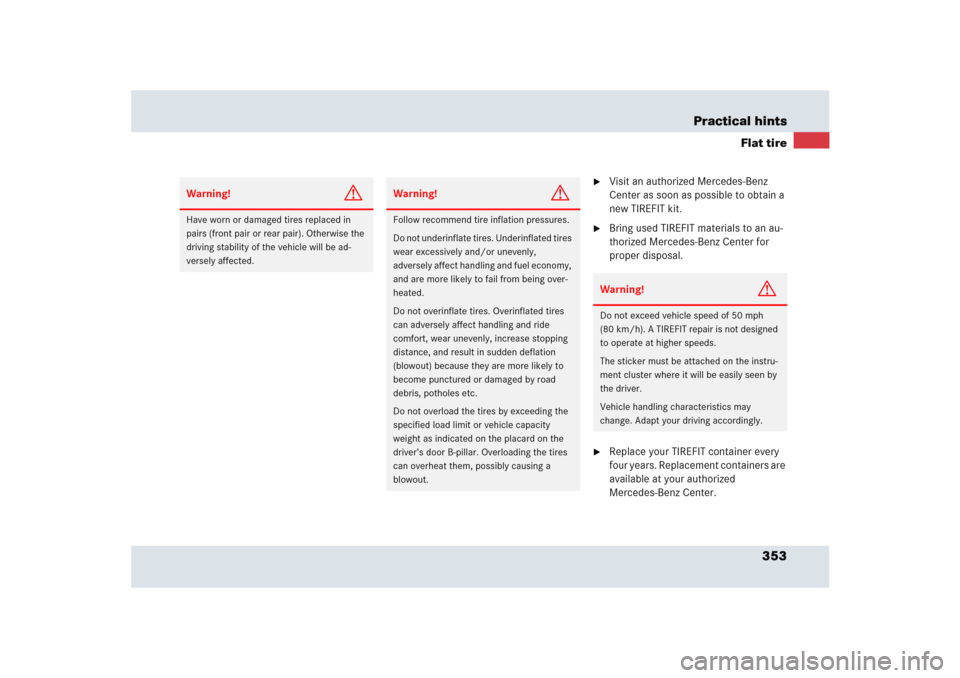
353 Practical hints
Flat tire
�
Visit an authorized Mercedes-Benz
Center as soon as possible to obtain a
new TIREFIT kit.
�
Bring used TIREFIT materials to an au-
thorized Mercedes-Benz Center for
proper disposal.
�
Replace your TIREFIT container every
four years. Replacement containers are
available at your authorized
Mercedes-Benz Center.
Warning!
G
Have worn or damaged tires replaced in
pairs (front pair or rear pair). Otherwise the
driving stability of the vehicle will be ad-
versely affected.
Warning!
G
Follow recommend tire inflation pressures.
Do not underinflate tires. Underinflated tires
wear excessively and/or unevenly,
adversely affect handling and fuel economy,
and are more likely to fail from being over-
heated.
Do not overinflate tires. Overinflated tires
can adversely affect handling and ride
comfort, wear unevenly, increase stopping
distance, and result in sudden deflation
(blowout) because they are more likely to
become punctured or damaged by road
debris, potholes etc.
Do not overload the tires by exceeding the
specified load limit or vehicle capacity
weight as indicated on the placard on the
driver’s door B-pillar. Overloading the tires
can overheat them, possibly causing a
blowout.
Warning!
G
Do not exceed vehicle speed of 50 mph
(80 km/h). A TIREFIT repair is not designed
to operate at higher speeds.
The sticker must be attached on the instru-
ment cluster where it will be easily seen by
the driver.
Vehicle handling characteristics may
change. Adapt your driving accordingly.
Page 361 of 417
360 Practical hintsTowing the vehiclePoints to bear in mind�
The vehicle must not be tow-started.
�
If the vehicle is to be towed, only tow it
with all wheels on the ground.
�
If the vehicle has suffered transmission
damage, only tow it with the propeller
shaft disconnected.
�
Before towing the vehicle, make sure
the battery is connected and charged.
Otherwise you will not be able to switch
on the ignition and move the selector
lever to N. There will then be no power
assistance when steering and braking.
Transporting the vehicle
The towing eye bolt can be used to pull the
vehicle onto a trailer or transporter for
transporting purposes.�
Move the selector lever to N.!Due to the low clearance height of the
SLR, care must be taken when loading
and unloading from a transporter to
avoid damaging the vehicle body work.
To secure the vehicle, only tie it down
by the wheels or tires. Otherwise it
could be damaged.